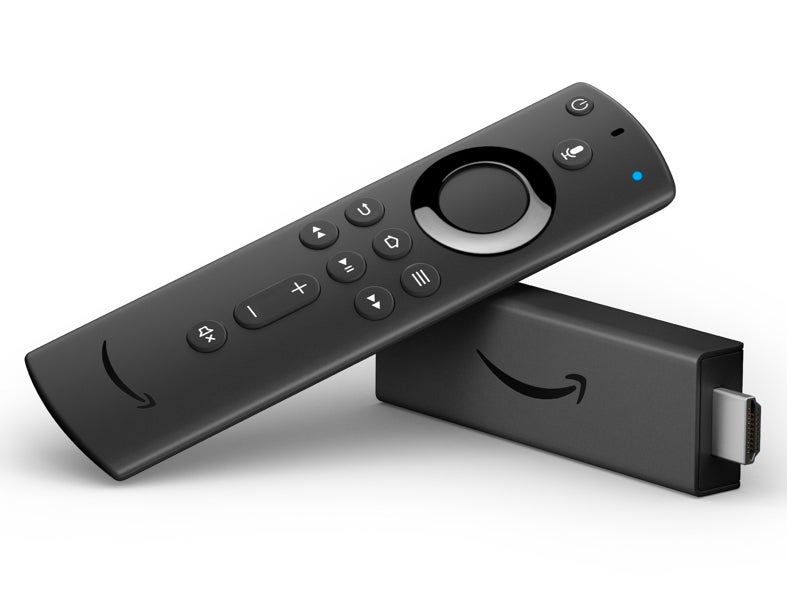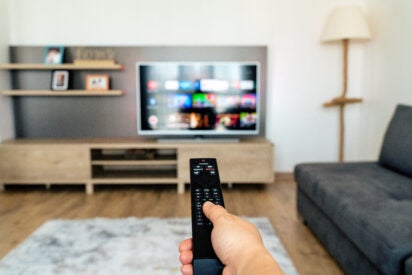Not all TVs are smart, but you can increase your TV’s internet capability regardless of its age. There are several easy (and affordable) options for turning your older TV smart — and they don’t require an IT degree to set up. There are also smart TVs already programmed with the ability to seek out your network so you can start enjoying your new streaming options.
How to connect your smart TV to your home network
New smart TVs are extremely easy to add to a Wi-Fi network. Ensure you have your wireless network name (SSID) and password before connecting.
You can use the remote that came with the TV to select Settings and navigate to a “Network” or “Wireless Connection” option, where your Wi-Fi network should appear. Enter the password with the remote, and you’re done.
If you want to connect via an Ethernet cable, connect the cable to your router or gateway and then to your TV’s port. Follow the same steps to find your network settings, selecting the “enable wire internet” option. It may be worded differently depending on the type of TV you have, but there will be a similar option.
Smart TV options
| TV | Price | Details |
|---|---|---|
| Amazon Fire TV 50″ | $$$ | • 4-Series 4K UHD smart TV • Stream live without cable • Gaming support • Supports Netflix, Prime Video, Disney+ and more |
| Roku 40″ Select Series | $$ | • 1080p Full HD • Supports Roku voice and other smart home apps • Supports major streaming apps |
| TCL 65-Inch Class S4 | $$$ | • 4K LED with Fire TV • Supports Alexa, Apple Airplay • Netflix, Prime Video, Disney+, Peacock, and more |
*$: under $100 $$: $100 to $200 $$$: Above $200
3 ways to connect any TV to Wi-Fi
1. Purchase a streaming device
Using a streaming device is by far the most user-friendly way to connect your TV to your home Wi-Fi. In most cases, they plug into your TV’s HDMI port and power outlet to bring every streaming app out there right to your screen. (There are a few exceptions here and there, but they’re rare.)

Image credit: Amazon
Streaming devices generally start around $30 and go up to over $130. If you think you might be upgrading to a 4K TV soon, it might be worth going with a 4K streaming device. While your new 4K TV would be able to connect to the internet directly, streaming devices almost always provide a better user experience, and they generally give you access to more apps than smart TVs.
Streaming devices
| Device | Price | Details |
|---|---|---|
| Google Chromecast with Google TV (4K)- Streaming Stick | $ | • Supports Netflix, Hulu, Amazon Instant Video, Google TV, YouTube • Supports 4K HDR |
| Apple TV 4K HD 32GB Streaming Media Player | $$ | • HDMI with Dolby Digital • Supports iTunes and Siri • Supports 4K |
| Amazon Fire TV Stick 4K streaming device | $ | • Supports Wi-Fi 6 • Free & live TV • 4K compatible • Supports Alexa, Netflix, Prime |
| Roku Express 4K Plus | $ | • Supports 4K HDR • Roku Voice • Free & live TV • Supports Netflix, Prime Video, Pandora, Hulu, Vudu, YouTube |
*$: under $100 $$: $100 to $200 $$$: Above $200
Keep in mind, no matter which streaming device you go with, you’ll still have to subscribe to apps like Netflix, Prime, YouTube TV or Hulu separately.
2. Use an HDMI cable
If you only plan on using your TV for streaming every once in a while, you can probably get by just fine with an HDMI cable. As it mirrors everything on your laptop, tablet or phone, you can use this method for things like sharing vacation photos or home videos as well.
Almost every laptop has an HDMI port built into it, so all you’ll need in this case is the cable itself. If you don’t already have one lying around the house, they generally cost around $10 new.
Connecting a smartphone or tablet usually requires an extra step. For Apple products, you’ll need a Digital AV Adapter, while most newer Android phones and tablets have a Type C connection (also known as USB-C) or Type D (Micro HDMI). Depending on which type your Android device uses, you may have to purchase an adapter.
3. Gaming console
If you’ve purchased a video game console in the past decade, you likely already have everything you need to connect your TV to Wi-Fi. Consoles as far back as PlayStation 3 (2006-2013) and Xbox 360 (2001-2013) come equipped with the ability to connect to the internet.
The newest versions like PlayStation 5 and Xbox Series S are fully compatible with your smart TV for a seamless online experience. If you are a heavy gamer, make sure you have the internet speed you need and the right modem or router to power your adventures.
Tips for getting the most out of your internet connection
Connecting your TV to the internet is only step one to a smooth streaming experience. We also recommend taking the following steps to ensure the dreaded buffering wheel never derails movie night.
Use an Ethernet cord if possible
While wireless connections have improved a ton in recent years, Ethernet cords still provide a more reliable connection in most homes. But because they plug into your wireless router, your TV will have to be relatively close to your router to use a wired connection. Of the four main streaming devices, only Apple TV has an Ethernet port on all of its models. For Amazon Fire TV Sticks and Google Chromecasts, you’ll have to purchase an adapter separately, while Roku only includes one on its most expensive model. You can learn more about choosing the right Ethernet cord in our guide.
Make sure you’re getting enough download speeds
Most streaming services recommend around 5 Mbps of download speeds for smooth, buffer-free streaming in HD — an easily reachable target for most homes. That said, the more devices are using your connection at once, the higher speeds you’ll need. If you’re not sure what speeds you’re currently getting, you can use our speed test below to find out.
Need more for the price?
Try these helpful hacks to improve your internet speed. Or if you just want more bang for your buck, check out providers near you with more speed for the price. Either way, we’ll help you find what you need.
View providers near meRather chat? Give us a call: (844) 451-2720
Rather chat? Give us a call: (844) 451-2720Pro Tip: For best results, use an Ethernet cord to connect your router or modem directly to your device before you run the test.
Relocate your router
If you are experiencing buffering issues, see if you can move your Wi-Fi router to a central and open location in your home. Radio signals move most easily through open-air, so reducing the number of walls your signal has to travel through can also boost your streaming quality.
If you’re still having Wi-Fi connection issues, a Wi-Fi extender or mesh router might also be worth the extra investment.
Connecting TVs to Wi-Fi FAQs
Most newer models of smart TVs have a built-in wireless adapter so you don’t need extra equipment to connect your TV to your home Wi-Fi network. However, if you have an older TV, a Wi-Fi adapter might be needed.
To make any TV smart, you can use its HDMi port to connect your TV to your router via an Ethernet cable.
Smart TVs usually have built-in tech to detect your network and allow you to connect via its settings options or remote.
See Allconnect’s News and Research hubs for more broadband guides and information.
Written by:
Robin LaytonEditor, Broadband Content
Robin Layton is an editor for the broadband marketplace Allconnect. She built her internet industry expertise writing and editing for four years on the site, as well as on Allconnect’s sister site MYMOVE.com. …
Read more

Edited by:
Camryn Smith-
Featured
![Cost of cable vs. streaming: Which is cheaper?]() Cost of cable vs. streaming: Which is cheaper? Camryn Smith — 4 min read
Cost of cable vs. streaming: Which is cheaper? Camryn Smith — 4 min read -
Featured
![How to control your TV with Alexa]() How to control your TV with Alexa Lisa Iscrupe — 4 min read
How to control your TV with Alexa Lisa Iscrupe — 4 min read -
Featured
![4 simple ways to connect your iPhone to your TV]() 4 simple ways to connect your iPhone to your TV Camryn Smith — 6 min read
4 simple ways to connect your iPhone to your TV Camryn Smith — 6 min read
Latest
-
Wednesday, April 24, 2024
Why do you need an Optical Terminal Network?Taylor Gadsden — 2 min read
-
Tuesday, April 23, 2024
Worried about losing your TV signal? This is how to keep your satellite dish cleanDavid Anders — 6 min read
-
Tuesday, April 23, 2024
How to change your Wi-Fi network passwordCamryn Smith — 2 min read






